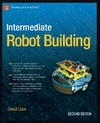For readers of Robot Building for Beginner (Apress, 2002 and 2009), welcome to the next level. Intermediate Robot Building, Second Edition offers you the kind of real-world knowledge that only renowned author David Cook can offer.
In this book, you’ll learn the value of a robot heartbeat and the purpose of the wavy lines in photocells. You’ll find out what electronic part you should sand. You’ll discover how a well-placed switch can help a robot avoid obstacles better than a pair of feelers. And you’ll avoid mistakes that can cause a capacitor to explode.
Want a robot that can explore rooms, follow lines, or battle opponents in mini-sumo? This book presents step-by-step instructions and circuit and part descriptions so that you can build the robot featured in the book or apply the modules to your own robot designs.
Finally, you’ll find the complete schematics for Roundabout, a room explorer that requires no programming and uses only off-the-shelf electronics. With Roundabout, you’ll use many of the same techniques used by professional robotics engineers, and you’ll experience many of the same challenges and joys they feel when a robot “comes to life.”
What you’ll learn
- How to build a robot from scratch
- Digital electronics and moderate machining
- How to use and integrate modern modules useful to all robots: power supplies, motor couplers, motor drivers (including H-bridges), opponent and obstacle detectors, and floor sensors.
- How to embrace and extend the base robot design
- How to use Roundabout, which operates with off-the-shelf brains, so that no programming is required
- How the additions of a microcontroller, configuration switches, and even a music module all come together as a final two-tier automaton showing a versatile Robot who is seemingly the master of its domain.
Who this book is for
This book is aimed at intermediate builders: adults, college students, and advanced high school students. It requires background experience in electronics, at least to the extent covered by Robot Building for Beginners.
Because the hobby involves soldering, electricity, and light machining, the writing is targeted toward individuals with those capabilities.
The book has been referenced in a number of high school and college courses.
Table of Contents
- Assembling a Modular Robot
- Comparing Two Types of Homemade Motor Couplers and Common Errors to Avoid
- Making a Fixture and Drilling Solid Rods for a Coupler
- Finishing the Solid-Rod Motor Coupler
- Building a Motor Inside a Wheel
- Understanding the Standards and Setup for Electronic Experiments
- Creating a Linear Voltage- Regulated Power Supply
- Making Robot Power Supply Improvements
- Driving Miss Motor
- Driving Mister Motor
- Creating an Infrared Modulated Obstacle, Opponent, and Wall Detector
- Fine-Tuning the Reflector Detector
- Roundabout Robot!
- Test Driving Roundabout
- If I Only Had a Brain
- Building Roundabout’s Daughterboard
- Adding the Floor Sensor Module
- Cooking Up Some Robot Stew
 |
|
О проекте
|
|
О проекте


